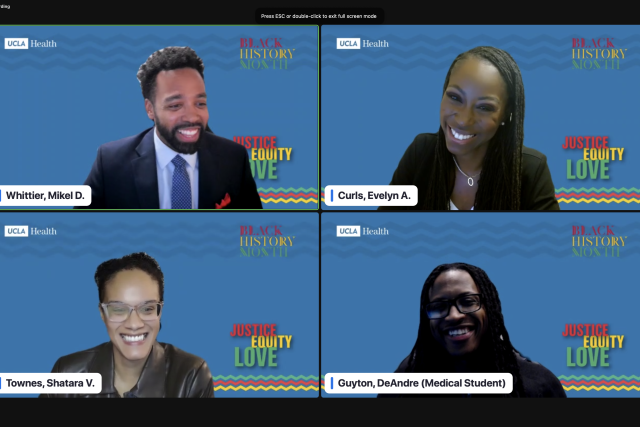Among the key elements of health justice are visibility, representation and inclusion, as Illuminated in a discussion among UCLA Health physicians and a David Geffen School of Medicine student.
Evelyn Curls, MD, Shatara Townes, MD and second-year medical student DeAndre Guyton joined UCLA Health’s Director of Health Equity, Diversity and Inclusion Mikel Whittier, DBA, on Feb. 22 for a virtual conversation in honor of Black History Month. The topic: How Black physicians are defining the future of health justice.
All three panelists said their childhood experiences inspired them to become physicians.
“In my formative years, I looked up to a character on television who was a physician — who was a pillar in his community, who was an excellent physician and provided culturally competent care to his patients,” Dr. Curls said. “As far back as I can remember, I always wanted to be a physician.”
Becoming a mom while still a teenager further cemented her decision, she said: “The care that I got, the discrimination that I faced as a black teenage mom trying to navigate the health care system, really pushed me to want to be a physician that wasn't like the ones that I encountered.”
Dr. Townes recalled loving the pediatrician who cared for her as a child growing up in South Los Angeles. ‘He was well-known in our community,” she said. “He was this Black man who I just thought was amazing and I aspired to be him one day. It was kind of tunnel vision from about the age of 5 or 6 of like: I’m going to be a physician.”
Guyton shared that his mother experienced cardiopulmonary arrest after giving birth to him, inspiring him to dream of becoming a doctor, “so I could be in the same position of a person that saved my mom’s life.”
“They’re the reason why I grew up with my mom and she was able to instill all these values in me,” he said.
Here’s what these medical professionals had to say on the key elements of health justice, which Dr. Curls defined as both “dismantling the systemic disparities that affect marginalized communities” and “as a Black patient, being able to enter any health care setting and receive respectful, equitable health care.”
Representation and visibility
Increasing visibility of Black doctors is crucial to drawing more Black students to the medical field and increasing trust with Black patients, panelists said. Only 5.7% of U.S. physicians are Black, according to the Association of American Medical Colleges.
Dr. Curls: “There’s plenty of studies that show that when the patient and the physician are racially concordant that there are better health outcomes for the patient. There’s kind of an inherent trust.
“What inspired us to become physicians was seeing Black physicians, and how they impacted the community and how they impacted patients. So it’s important for us to be involved and visible and in the community so we can spark that inspiration in future generations.”
Dr. Townes: “Black providers bring a very unique Insight and perspective to addressing health disparities that affect our community. We are trusted allies or trusted advocates within our communities, so we’re able to really bridge the gap between health care access and providing this culturally competent care that we know is the expectation of every health care provider.
“Visibility is really important … and really ensuring that our community knows that we’re here. And having more discussions like this, where folks can see people who are physicians and who are in this role and can speak to experiences that a lot of us share.”
Guyton: “We’re uniquely connected to our communities. I see the relief on certain patients’ faces when I walk into the room. If you’re a Black patient, and you immediately see somebody who’s Black like you, there’s usually a general comfort level.
“It would be wonderful if there were spaces made specifically for us (at the medical school). We make these spaces for ourselves, but it would be wonderful if there were spaces specifically for Black students within the structure of the institution itself.”
Inclusion
Dr. Townes: “Having these safe spaces and collegiality between Black students is really important, and promoting diversity and inclusion is a huge piece of that. There are moments of isolation and moments of loneliness when you are one of the few in whatever business or school. So really being cognizant of the diversity that exists, and ensuring that when we do have increased diversity, whether it’s in medical school, residency or faculty, that we are really promoting inclusion. We can have a lot of diversity, but if the folks at your institution do not feel included, then it kind of goes to the wayside.”
Dr. Curls: “Increasing the sensitivity and awareness of the faculty is a big step in making our students feel more included and that they are understood. I think there are a lot of micro aggressions that are witnessed that go unaddressed, and I don’t think it is because of a lack of care. It’s because of a lack of awareness. So anything that could increase that would be helpful.”





